American beautyberry (Callicarpa americana) is not only a beautiful shrub, but a regional food that foragers seek out every autumn.
When I first moved to the southeastern United States, I was fascinated with its bold magenta color berries, and after researching this wild beauty, I quickly adopted the local practice of fall foraging.
Today, I’m excited to introduce you to this amazing plant. In this post I’ll guide you through how to identify this wild edible, where to find it, and when to harvest both the berries and leaves. Whether you’re new to foraging, or an experienced wildcrafter, you’ll discover how this native plant can be a delicious and useful addition to your seasonal harvest.
Here’s how to forage American Beautyberries
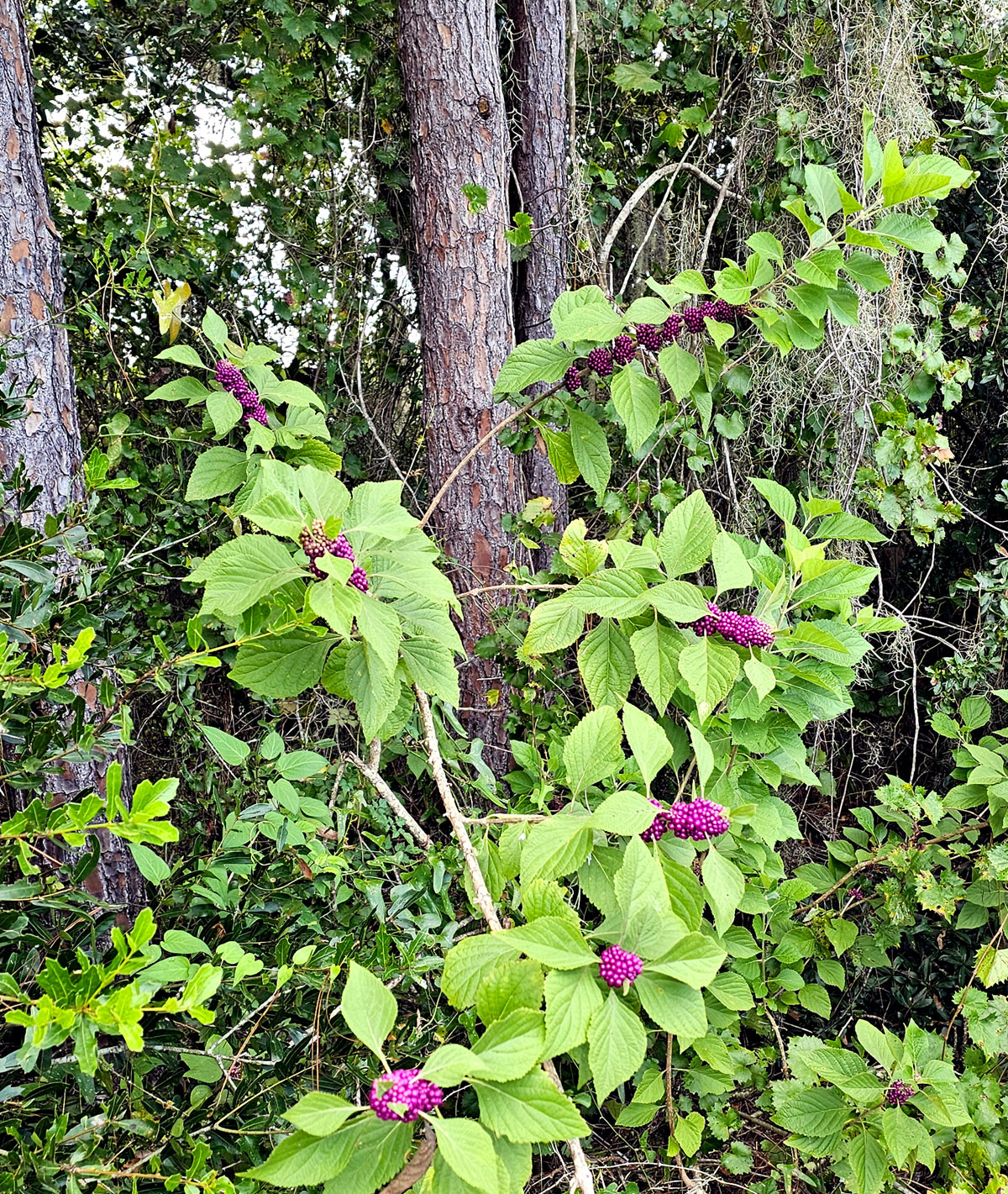
Table of Contents
- How to Identify American Beautyberry
- Where to Find Beautyberries
- Foraging Tips
- Uses for American Beautyberry
- Resources
- FAQs
How to Identify American Beautyberry
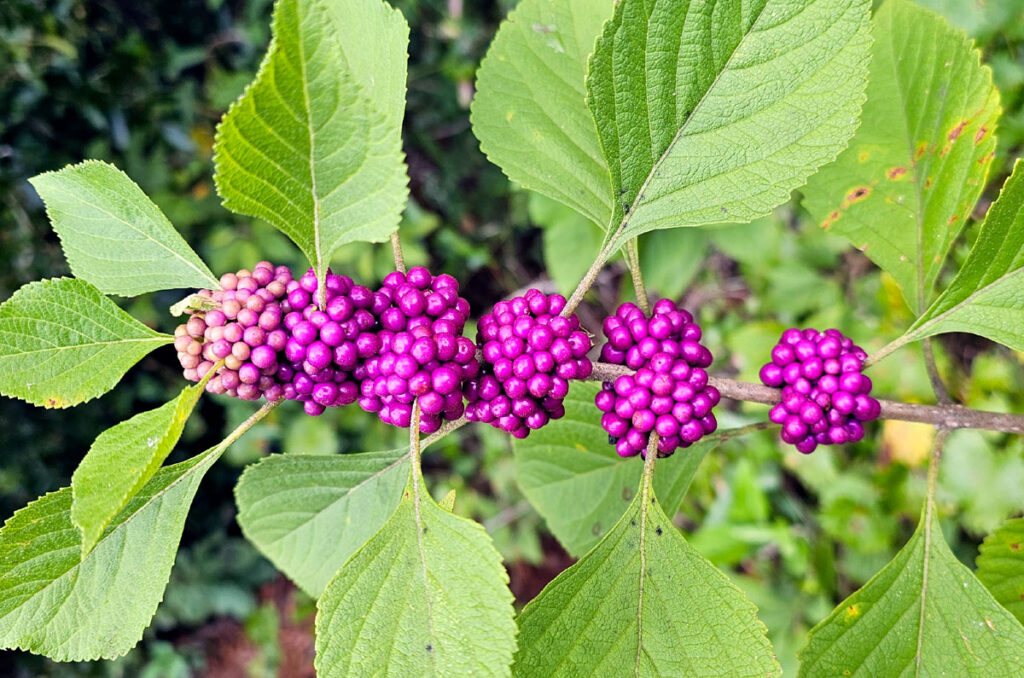
American beautyberry is a shrub native to the southeastern United States. Known for its vibrant magenta berry clusters that appear every autumn, this plant is not only beautiful, but useful as an edible, medicinal, and ornamental plant.
Its scientific name is Callicarpa americana. It is commonly known by other names such as French Mulberry, sourbush, bunchberry, or purple beauty-berry.
This fast-growing shrub is dormant during the winter months. Once spring arrives, pale green leaves appear and the stems begin their quick growth. These branches may grow several feet in length depending on growing conditions. I have several bushes on my property that have never been pruned and grew 7 feet tall. The shrub typically grows anywhere from three to eight feet in height with a three-to-six-foot sprawling diameter.
By late spring pale white flower with hints of pale blue, pink, or violet will form in clusters along the new growth. Over the summer, berries will form and turn from pale green to bright magenta by early autumn. The berries ripen gradually with the clusters closest to the main branch ripening first. The berries are about 1/8 inch in size with varying shades of purple and magenta. Each cluster of berries along the stem is about the size of a golf ball.
The berries will remain on the stems into winter, eventually drying and falling off soon after the leaves die off as well. Inside each berry are 2-4 small seeds that are black when the fruit is ripe. The berries are edible, yet very astringent.
Be aware that there are many types of beautyberries found around the world, most of them are not edible and are only used as decorative plants. Examples include: Japanese Beautyberry (callicarpa japonica), Purple Beautyberry (callicarpa dichotoma), and Welch’s Pink (C. americana “Welch’s Pink”).
For more details about the American Beautyberry and accurate plant descriptions, visit these reliable sources:
Where to Find Beautyberries
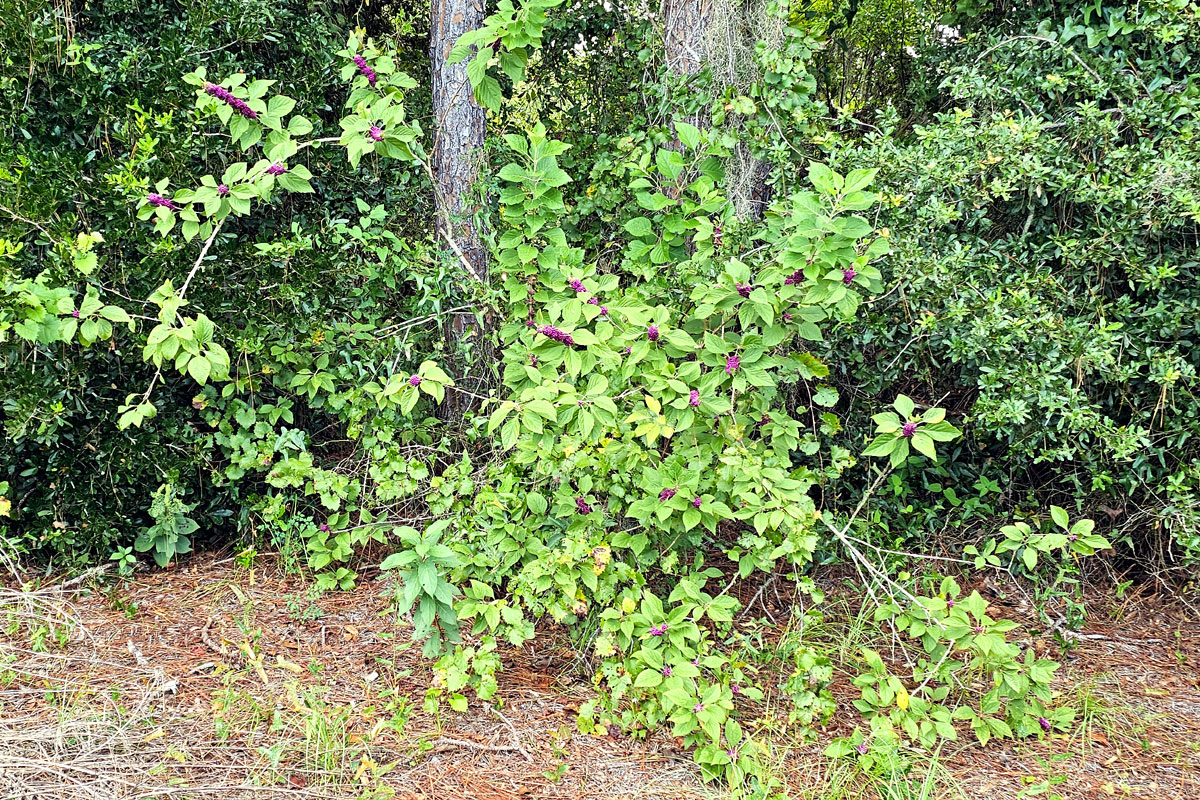
The American Beautyberry can be found from Virgina in the east and as far west as Texas. It grows in USDA hardiness zones 6-10.
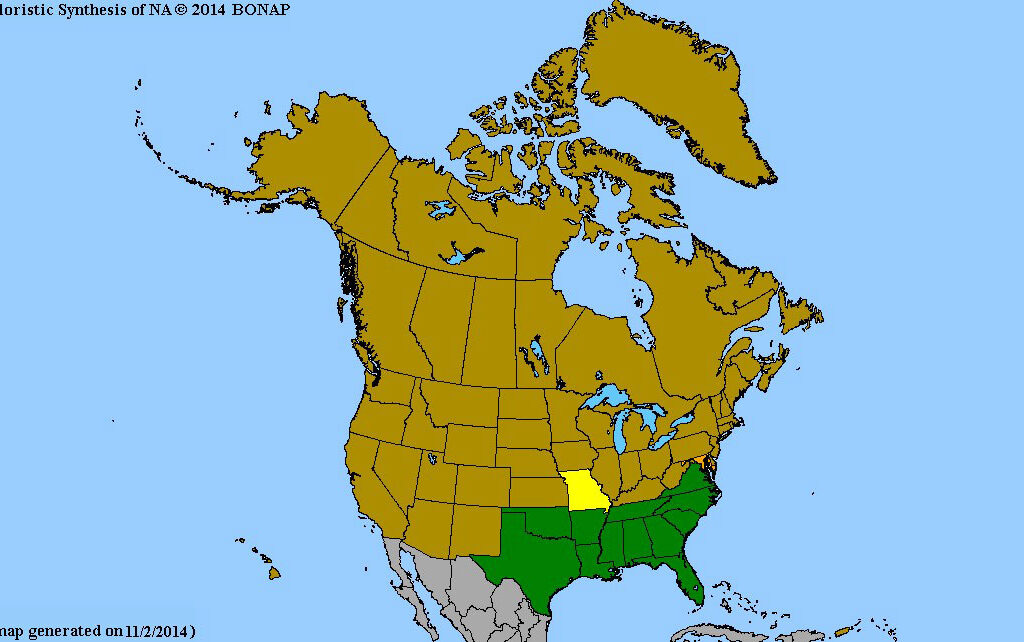
The best place to find the American beautyberry is under open stands of pine. It can also be found along hedgerows, fence lines, growing in abandoned pastures, or in meadows. It is a pioneer species and prefers recently disturbed land such as deforested areas or where wildfires have passed.
Being a pioneer species, American beautyberry can tolerate a wide range of soils from acidic to mildly alkaline. It prefers average soil moisture with good drainage. Our Florida sandy soil is the perfect environment for these shrubs to thrive in.
The easiest way to find wild beautyberries is during the fall, either drive around back roads, or hike trails where these conditions are present. The bright magenta berries make them easy to spot. Research online or ask around to find people who regularly forage or conduct foraging walks. If you have good growing conditions for beautyberries, consider buying them from a regional or local nursery to grow on your own property. You can also grow them from seeds of ripe berries.
Foraging Tips & Best Practices
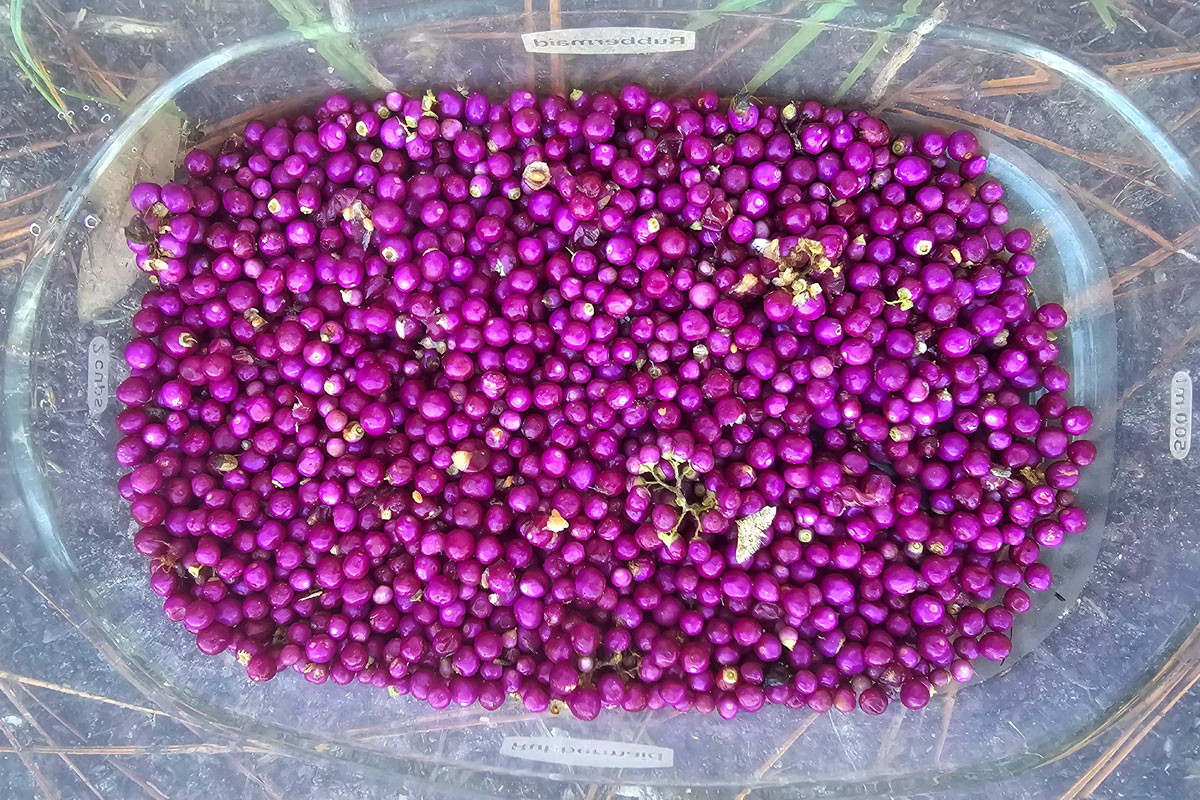
Now that we’ve covered how to identify American beautyberry and where to find it, here’s a step-by-step guide to harvesting the ripe fruit.
Choose the right time to harvest. Beautyberries ripen from August through October. They ripen gradually over time, not all at once. This offers you the opportunity to forage more than once during a season.
Look for clean, healthy plants. Seek out clean, healthy plants by foraging in areas free from pesticides or harmful chemicals—avoid plants near roadsides, which are often contaminated. Inspect the beautyberry bushes carefully, steering clear of any that appear moldy, stunted, diseased, or have an unusually high number of insect pests. Keep in mind that the plant’s leaves naturally yellow and die off as the fruit ripens, so this is part of the normal life cycle and not a sign of illness.
Harvest the berries. Look for berries that are plump and bright in color. They can range from deep purple to reddish-magenta. The berry clusters will ripen from the lowest cluster on the branch up to the highest.
The easiest way to harvest the berries is to first give the branch a strong tap then a gentle shake to knock off bugs. This will not dislodge the fruit, but will help get rid of existing pests. I’ve found spiders, green stink bugs, ants, and leaf-footed bugs while harvesting. If mosquitoes are flying around crush some of the beautyberry leaves and rub them on your exposed skin. The chemicals in the leaves help deter mosquitoes, ticks, and no-see-ums.
Next, hold a container under the berry clusters and gently rub your fingers over the fruits, dislodging the ripe berries. If any berries still cling to the branch, they are not fully ripe. Leave them for harvesting later or for the multitude of wildlife for food. Finally, pick out any leaves, debris or insects that may have fallen in your container.
Harvest the leaves. Beautyberry leaves contain chemical compounds called callicarpenal, intermedeol, and spathulenol, which have been shown to repel a variety of pests including mosquitoes and ticks. These compounds make beautyberry leaves useful for making homemade insect repellents by crushing the leaves, making a tincture or spray. A simple online search will give you many recipe ideas.
To harvest the leaves, choose only green, vibrant leaves free from any visible diseases or pests. Harvest mid-morning, after the dew has dried, but before the sun causes the leaves to wilt. Use clean, sharp tools to cut the leaves and minimize spreading disease. Take only a few leaves from each branch to avoid stressing the plant.
Use sustainable harvesting practices. Only take what you will use. I plan my recipes in advance, then gather just enough to match the ingredients required. For example, if a jelly recipe calls for 6 cups of beautyberries, I’ll harvest about 7 cups to account for any damaged or unripe berries collected along the way. This ensures minimal waste while leaving plenty for wildlife and further growth.
Here are some general foraging practices that will ensure you not only enjoy the benefits of foraging, but also help preserve the natural environment for wildlife and others who may pass by.
- Know the local regulations. Be aware of local foraging laws and whether the land you’re on is private or public.
- Leave no trace. Respect the environment and the creatures that live there. Be careful not to disturbed vegetation or other plants when foraging.
- Avoid overharvesting. As stated above, only take what you need and leave the rest for wildlife and plant regeneration.
- Be aware of look–alikes. While American beautyberry is easy to identify, be sure it’s the correct variety. Refer to the references above or a local foraging expert if in doubt.
- Give back to nature. Consider spreading excess seeds in favorable locations or refrain from foraging in delicate ecosystems.
Uses for American Beautyberry
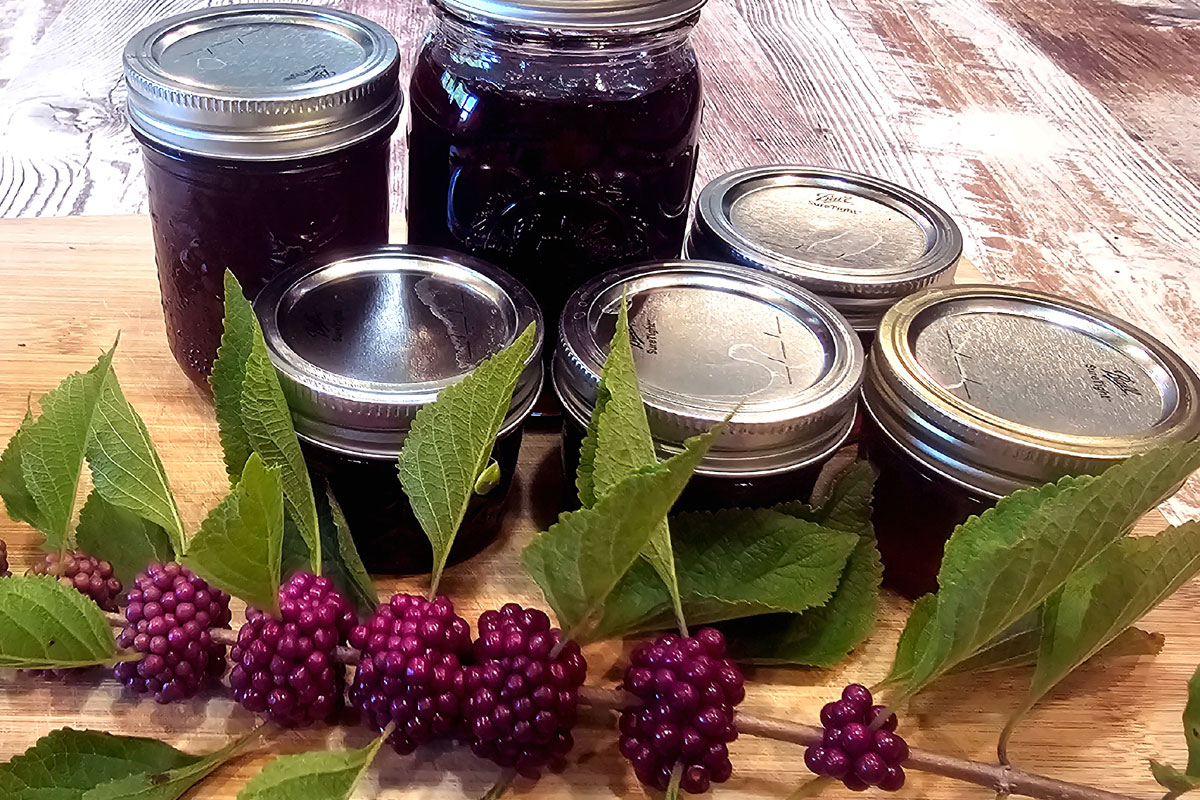
The American beautyberry is a versatile native shrub that you can use in a variety of ways including culinary, medicinal, and decorative. Here is a list of its various benefits for you to explore.
Culinary
- Jams and jellies
- Syrup
- Tea
- Wine
Medicinal (traditional uses)
- Leaf tea for digestion
- Root tea for dysentery and stomach aches
- Leaves as an insect repellent
Decorative
- Fresh or dried arrangements
- Hedge or ornamental shrub in the landscape
- Berries used as a natural dye

Resources
While much of the above information is from my own personal experience, I’ve also consulted various reliable resources to verify the details such as the botanical name, plant varieties, and other facts. Below is a list of resources for further reading and to deepen your knowledge of the American Beautyberry:
- American Beautyberry (Wikipedia)
- USDA Map American Beautyberry Growing Zones
- A list of different types of beautyberries
- Beautyberry Leaf as an insect repellent
- USDA Plant Profile – American Beautyberry
FAQs
While they’re not toxic, the raw berries have a bland to slightly bitter taste. They’re best used in recipes rather than eaten raw.
While there are other Callicarpa species, they’re also non-toxic. The main concern is ensuring you’re not confusing it with completely different plants. However, always be 100% certain of your identification before consuming any wild plants.
Berries can stay on the plant well into winter, providing food for birds and other wildlife.